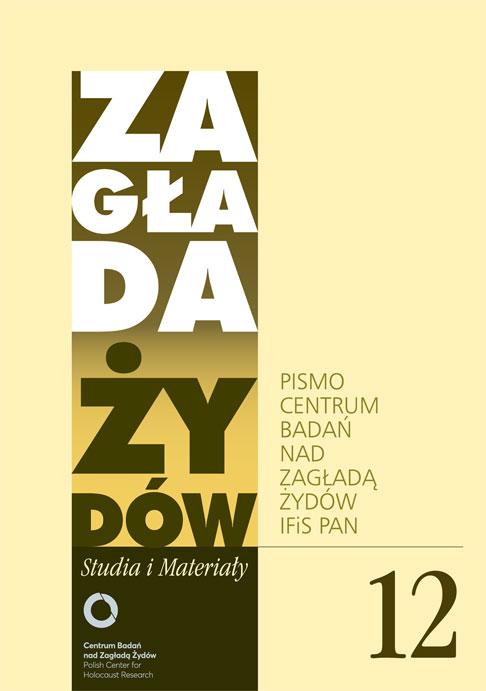Frankenstein w warszawskim getcie. Historia i legenda
Zagłada Żydów. Studia i Materiały, Nr 12 (2016), Strony: 187-208
Data zgłoszenia: 2020-10-19Data publikacji: 2016-11-30
 https://doi.org/10.32927/ZZSiM.414
https://doi.org/10.32927/ZZSiM.414
Abstrakt
The article deals with one exceptionally violent German perpetrator who was part of the occupation force in Warsaw during the Second World War. Inside the Ghetto he maltreated and killed a large number of women, children and men for his own personal pleasure. He did this to such an extensive degree that the population perceived him as monstrous being that was given the nickname „Frankenstein”. The article is mainly based on statements in juridical investigations, from the victim as well as from the perpetrator perspective, supplemented with some selected additional sources. Firstly the source corpus will be evaluated, to work out how these historical sources can be used to shed light on „Frankenstein”. This will be followed by an analysis of the actual identity of this perpetrator. It will be shown that he was, contrary to common belief, not necessarily the SS-Rottenführer Josef Blösche but more likely a member of the German Police Battalion 61. In the end the question will be also raised of how it was possible – despite all rules and regulations – that ghetto guards like him behaved like a marauding soldiery.
Słowa kluczowe
getto warszawskie , Zagłada , policja umundurowana , zbrodnie okupacyjne , warty w getcie , batalion policyjny , sprawca , przemoc , strach , terror , życie w getcie
Licencja
Prawa autorskie (c) 2016 Autor&"Zagłada Żydów. Studia i Materiały"

Utwór dostępny jest na licencji Creative Commons Uznanie autorstwa 4.0 Międzynarodowe.
https://creativecommons.org/licenses/by/4.0
Czasopismo publikowane jest w standardzie Diamond Open Access na licencji CC-BY-4.0 Deed - Uznanie autorstwa 4.0 Międzynarodowa - Creative Commons
Podobne artykuły
- Adam Kopciowski, Szama Grajer – „żydowski król” z Lublina , Zagłada Żydów. Studia i Materiały: Nr 16 (2020)
- Elżbieta Janicka, Instead of negationism. The symbolic topography of the former Warsaw ghetto vis-à-vis Holocaust narratives , Zagłada Żydów. Studia i Materiały: Nr Holocaust Studies and Materials (2017)
- Ewa Wiatr, Ruch hachszarowy w getcie łódzkim 1940–1941 w świetle dokumentów. , Zagłada Żydów. Studia i Materiały: Nr 16 (2020)
- Kaja Kaźmierska, Krzysztof Malicki, Poza wspólnotą pamięci. Życie i zagłada Żydów w pamięci mieszkańców rejonu podkarpackiego, Warszawa: Wydawnictwo Instytutu Filozoϐii i Socjologii PAN, 2017, 363 s. , Zagłada Żydów. Studia i Materiały: Nr 14 (2018)
- Michał Głowiński, Jan Błoński "Biedni Polacy patrzą na getto” w 20 lat później , Zagłada Żydów. Studia i Materiały: Nr 2 (2006)
- Agnieszka Haska, Międzynarodowa konferencja naukowa „Być świadkiem Zagłady”(Warszawa, 22–23 kwietnia 2013 r.) , Zagłada Żydów. Studia i Materiały: Nr 9 (2013)
- Redakcja, Od Redakcji , Zagłada Żydów. Studia i Materiały: Nr 8 (2012)
- Adam Puławski, Jacek Andrzej Młynarczyk, W cieniu Zagłady. Losy kieleckich Żydów w czasie drugiej wojny światowej [Adam Puławski] , Zagłada Żydów. Studia i Materiały: Nr 17 (2021)
- Dariusz Libionka, Jan Grabowski, Meldunki Obwodu „Praga” Policji Polskiej o zatrzymaniach Żydów w Warszawie w okresie maj–lipiec 1943 r. , Zagłada Żydów. Studia i Materiały: Nr 10 (2014)
- Grzegorz Rossoliński-Liebe, Ukraińska policja, nacjonalizm i zagłada Żydów w Galicji Wschodniej i na Wołyniu , Zagłada Żydów. Studia i Materiały: Nr 13 (2017)
<< < 1 2 3 4 5 6 7 8 9 10 11 12 13 14 15 16 17 18 19 20 21 22 23 24 25 26 27 28 29 30 31 32 33 34 35 36 37 38 39 40 41 42 43 44 45 46 47 48 49 50 > >>
Możesz również Rozpocznij zaawansowane wyszukiwanie podobieństw dla tego artykułu.
 English
English
 Język Polski
Język Polski




